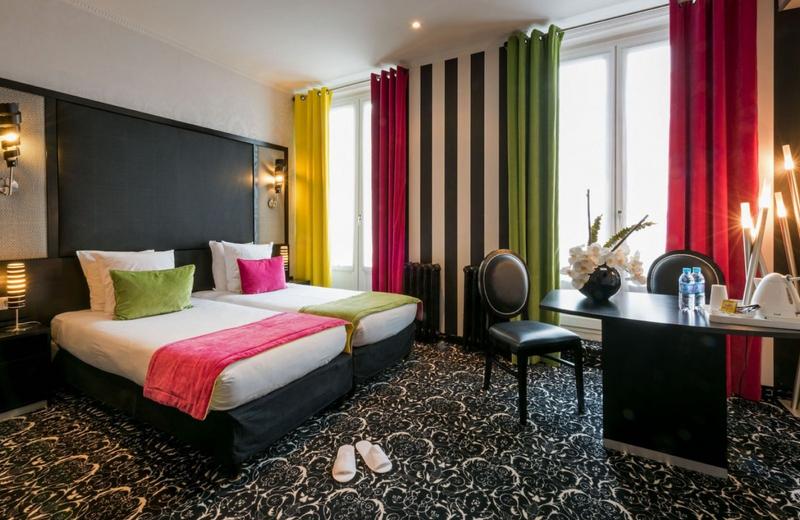Our history
The first ancestors of the current operator being interested in hotels, or rather catering, lived in Touraine region, in a small village in Loir et Cher, located 3 kilometers from the Chateau de Chenonceau.
In the early nineteenth century, Mary Faisan, daughter of a winemaker, marries Anatole Ouchet, son ofa winegrower and baker by profession. They open the Café Ouchet and organize banquets in their facility for the villagers. Weddings, baptisms, funerals and religious festivals punctuate rural life.
They have two children: Leo (1888-1917) and Lea (1880-1949). Leo died very young on the battlefields of the First World War; before he died he created with his future brother-in-law a boarding house, the Leo's Hotel at 33 rue Nollet 75017 Paris. Lea, married Sylvain Gaudion, son of farmer. They settled in Bois Colombes (92) where Sylvain works. During the First World War, he leaves for the front and never returns, leaving Lea alone with her two children Jean (1903-1956) and Marthe (1917-2004). Times are tough, you have to live or even survive. Lea rents rooms in her house in order to provide a decent education for her children. But the money earned from the rental of a few rooms to Commercial Workers is not enough to pay for the studies of her children. Lea decides to go into debt to purchase a hotel - Modern Hotel in Paris in the 17th district to allow Jean to finish his engineering studies and Marthe her business education.
Alongside their studies, both children help their mother to maintain the hotel: hand wash the clients sheets, make necessary purchases, cutting wood for wood stoves used to heat the hotel, washing floors and bathrooms, prepare breakfast ...
Jean graduated engineer of Roads and Bridges; In the meantime, he participates in the hotel work. Marthe began her professional career in the medical field, and integrates the management of Gaz de France. Upon completion of her work, she does not hesitate to crossParis by bike every day to start a new working day at the hotel.
But Marthe mostly enjoys to welcome the customers. She loves to greet people, learn, listen, ensuring their comfort both material and moral. When the opportunity arises, she spends more and more time at the reception. Se is very appreciated by the guests for her kindness and helpfulness. And ... what would happen, happened!
She meets one of her customers coming from his native southeast region to study and that will lead to a position in the public service. Her mother died. She married, then with him in 1955. She purchases with her brother a bigger hotel, leaving the 17th for the 8th district and take over the management of Orient Hotel, at 16 rue de Constantinople. In 1956, they take over the management of Hotel Pax, 47 rue de Trévise 75009 Paris.
Jean Gaudion dies.
The clientele changes; they are no longer employees of commerce that come to stay but mainly tourists, from French province or abroad. The hotel is well located in the center of Paris and indeed within walking distance of the main tourist spots. In this time of post-war Paris "the most beautiful city in the world 'dream: the Eiffel Tower, the Sacred Heart, the Grands Boulevards, the Opera, the Champs Elysées are fashionable. And Folies Bergere,which are two steps away, are frequented by a cosmopolitan clientele and eager for fun.
Years pass, Marthe and her husband have a daughter. They acquire another establishment in 1973: Hotel Peyris in the 9th district near the National Conservatory of Dramatic Arts, rue du Conservatoire. Their daughter joined the family business in 1983 and married a few years later. The couple became head of both hotels. It decides to give new life to Hotel Pax. In 1996, the Pax hotel gets its third star and becomes the Hotel Pax Opera.
The company is restructured, the sales department is established with the creation of a business event (exhibitions, musical evenings, sales exhibitions of decorative objects). The aging decor is dusted. General management, in collaboration with young designers, revisits decoration working around the theme of the opera; intimate areas are managed in public areas; Yvette Maniglier (last pupil of the painter Henri Matisse), familiar of the hotel, produces paintings, inspired by the new atmosphere that emerges. They now punctuate places of relaxation.
2006 marks the 50th anniversary of the hotel.
With the transition to the twenty-first century, the image of the hotel Pax Opera is evolving. Each client is received at home in a house where every staff member is to listen to its demands, far from impersonal and standardized welcoming. The charming hotel becomes a boutique hotel.
Last artistic touch: abstract paintings, painted by the current operators (under the name of Sylvie R. or Yo) decorate every room. They were designed in harmony with the tones ofeachone and provide thus a cheerful, dynamic and contemporary decor in this atypical final grade.


